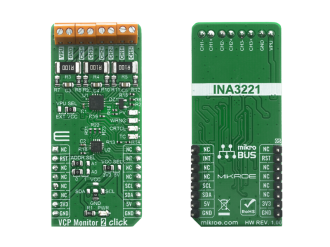
We strongly encourage users to use Package manager for sharing their code on Libstock website, because it boosts your efficiency and leaves the end user with no room for error. [more info]

Rating:
Author: MIKROE
Last Updated: 2020-06-17
Package Version: 1.0.0.0
mikroSDK Library: 1.0.0.0
Category: Current sensor
Downloaded: 3710 times
Not followed.
License: MIT license
VCP Monitor 2 Click is a three-channel, high-side current and bus voltage monitor with alert indication function ensuring the intended application works within desired operating conditions.
Do you want to subscribe in order to receive notifications regarding "VCP Monitor 2 click" changes.
Do you want to unsubscribe in order to stop receiving notifications regarding "VCP Monitor 2 click" changes.
Do you want to report abuse regarding "VCP Monitor 2 click".


Library Description
The library contains basic communication with the module and allows the user to read and write data to the module. The user can read the current data of current, voltage and power measured by the sensor.
Key functions:
float vcpmonitor2_get_shunt_voltage ( uint8_t channel ) - Get Shunt voltage in mVfloat vcpmonitor2_get_current ( uint8_t channel ) - Get Current data in mAfloat vcpmonitor2_get_power ( uint8_t channel ) - Get Power in WExamples description
The application is composed of three sections :
void application_task ( )
{
mikrobus_logWrite( ">> CHANNEL 1 <<", _LOG_LINE );
display_channel_data( VCPMONITOR2_CHANNEL_1 );
mikrobus_logWrite( ">> CHANNEL 2 <<", _LOG_LINE );
display_channel_data( VCPMONITOR2_CHANNEL_2 );
mikrobus_logWrite( ">> CHANNEL 3 <<", _LOG_LINE );
display_channel_data( VCPMONITOR2_CHANNEL_3 );
display_alert_status( );
mikrobus_logWrite( "---------------------", _LOG_LINE );
Delay_ms( 4000 );
}
Additional Functions :
Other mikroE Libraries used in the example:
Additional notes and informations
Depending on the development board you are using, you may need USB UART click, USB UART 2 click or RS232 click to connect to your PC, for development systems with no UART to USB interface available on the board. The terminal available in all MikroElektronika compilers, or any other terminal application of your choice, can be used to read the message.